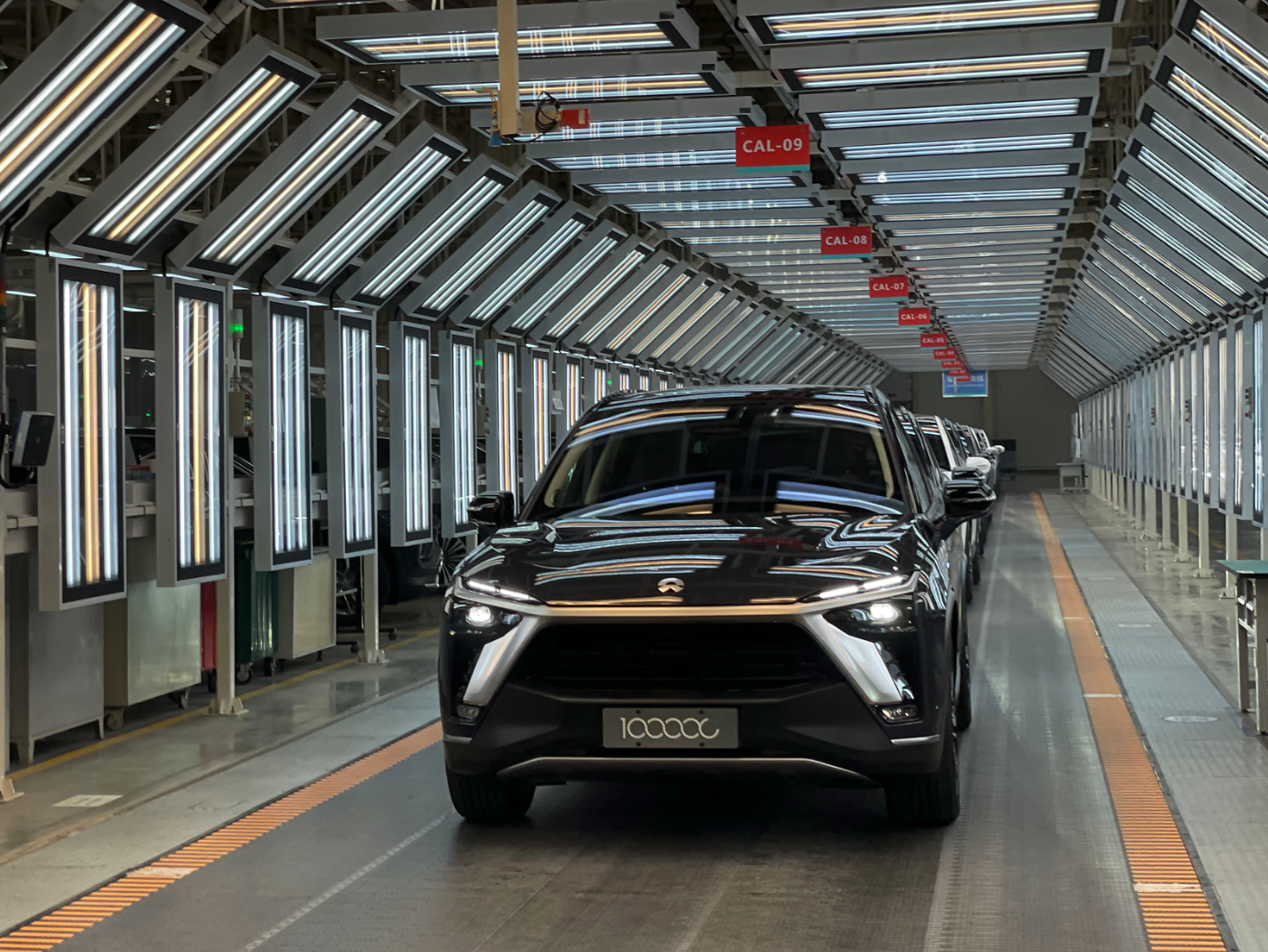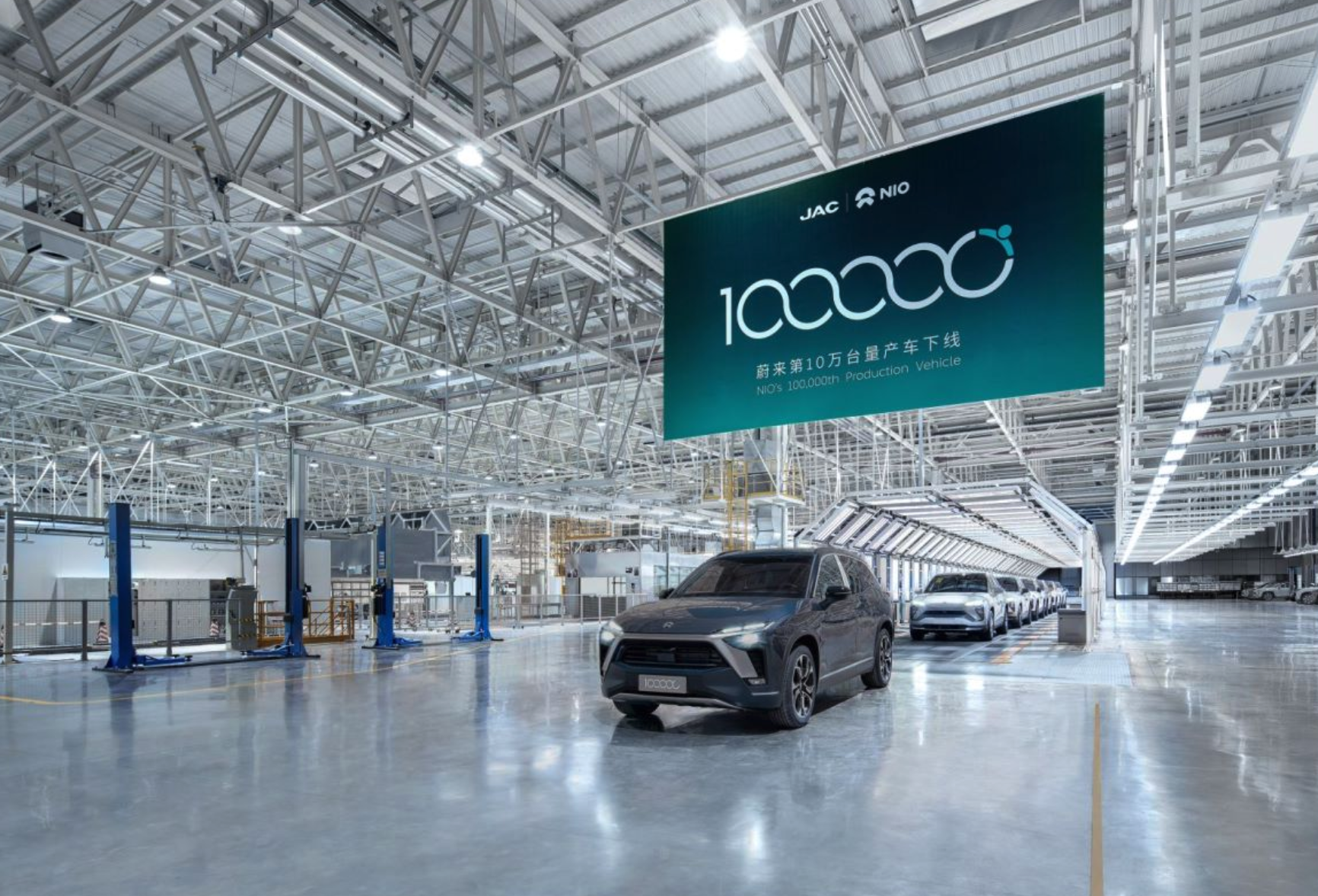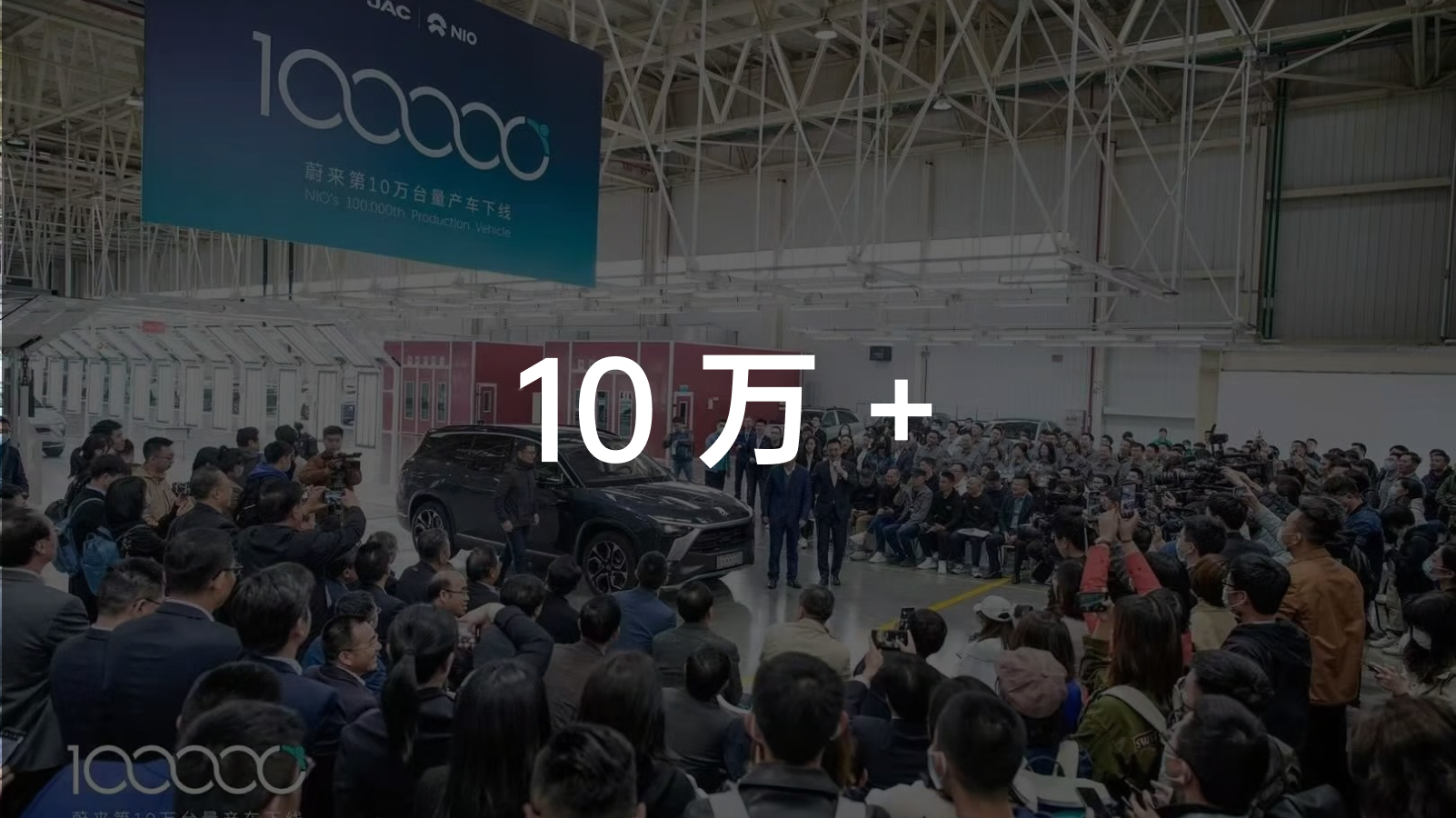In an environment where nine out of ten people might think it’s not reliable, the first NIO ES8 was rolled off the production line in May 2018, and the first batch of ten ES8s were delivered on May 31st of the same month. However, all ten users were NIO employees, including Qin Lihong, CEO of NIO, and Li Tianshu, known as the father of NOMI.
At that time, this move not only impressed the insiders, but also made Shen Hui, the founder of WM Motor, openly declare that the biggest challenge for new forces in car-making is real delivery to ordinary consumers, rather than just delivering to internal employees or acquaintances.
On November 27, 2018, the ten-thousandth ES8 was rolled off the production line, which prompted He XPeng, founder of XPeng Motors, to “self-pay” for one ES8 and drove it home.
Subsequently, on May 28, 2019, the first ES6 was rolled off the production line. To be honest, I believe that in addition to the efforts of NIO car owners to shoulder the “sales task,” the ES6, which was “unparalleled” at that time, was also an important factor that helped NIO recover from ICU.
On July 18, 2020, the 50,000th NIO vehicle was rolled off the production line, which took a total of 783 days from the first vehicle to the 50,000th.
And today, on April 7, 2021, with a Antarctica Blue ES8 driving off the production line, it took only 263 days for NIO to roll off another 50,000 vehicles, totaling 100,000. This time, the production time has been reduced by two-thirds compared to last time.

Today, NIO Founder and Chairman Li Bin and CEO Qin Lihong accepted media interviews at the 100,000-vehicle-off-the-line event.
Li Bin said at the opening that he was only slightly excited today, after all, this is just a small beginning, and selling how many cars is only a natural outcome. Our company has always aimed to become the most user-satisfied company and brand.
With a simple sentence, I vaguely felt that NIO might set another “high-profile” target.
Production Capacity Is the Key
Since the event is held in the factory and the theme is 100,000-vehicle-off-the-line, NIO’s production capacity has become the focus of discussion.

Li Bin also mentioned that due to the shortage of chips before the holiday, the factory was shut down for five days, and NIO was affected by the scarcity of the supply chain, including the battery production capacity in addition to the chips.Let’s first talk about chips. Li Bin mentioned that the imbalance between supply and demand in the automotive chip industry is mainly due to a shortage of basic chips, particularly a $1 chip, which has put significant pressure on NIO’s supply chain in the second quarter. The situation is expected to ease in the third quarter.
At present, NIO’s goal is to maintain a monthly supply chain production capacity of 7,500 vehicles, but there is still some pressure.
It is worth mentioning that NIO is not too broke to afford a $1 chip. It is just that during the pandemic, chip manufacturers such as TSMC believed that the automotive industry would not recover so quickly, resulting in an 8-inch wafer order reduction related to mature process chips.
Towards the end of last year and early this year, TSMC resumed purchasing 8-inch wafer orders. However, due to the manufacturing cycle of the wafer and chip, the industry generally believes that chip supply will return to normal in the third quarter.
Moving on to batteries, Li Bin stated that the demand for 100 kWh battery pack exceeded their expectations. Especially, the ratio of BaaS users who opt for 100 kWh battery packs was higher than what they had anticipated. However, the battery production capacity is also expected to see a considerable increase in the third quarter.
As BaaS users pay a monthly rental service fee of at least 1480 yuan for a 100 kWh battery, it is safe to say that this cost is not cheap. Therefore, the high demand for 100 kWh batteries was unexpected.
Moreover, Li Bin also mentioned that if it weren’t for supply chain disruptions, the factory had achieved a capacity of 400 vehicles per day in March. This meant that NIO had the capacity to produce over 10,000 vehicles per month.
What is interesting is that Li Bin stated, “We have already released our first sedan product, and there will definitely be a second sedan product with stronger competitiveness than the Tesla Model 3.”
Combining Li Bin’s previous statement that NIO would not produce vehicles priced below 300,000 yuan in the short term, we predict that the starting price for the next NIO ET5 will be approximately 300,000 yuan, and the price after BaaS will range from 230,000 to 240,000 yuan.
For the above reasons, Li Bin also mentioned that although NIO is expanding its production capacity with plans to produce 150,000 vehicles annually with a single shift and 300,000 vehicles annually with double shifts, one factory alone cannot fulfill the follow-up plan. Therefore, NIO plans to announce the establishment of an intelligent automobile industrial park in Hefei on April 29th, coinciding with the first anniversary of the cooperation agreement with Hefei.
Apart from production capacity, the discussion also raised concerns about the “window period,” considering that the delivery time for the NIO ET7 is in 2022, which means that there will be no new NIO vehicle this year. How to navigate this window period is also a focus.
Li Bin believes that the current NIO models for sale are relatively “young.” The ES6, which has been in production for the longest time, has only been delivered for a year and a half, while the new ES8 and EC6 are only a year and a half and half a year, respectively.The three things that NIO will continue to work on are: first, further tapping into the capabilities of the first-generation hardware platform, which means continuous software updates. Second, accelerating the deployment of battery swapping stations, and Li Bin mentioned 500 stations as an external goal, but the internal target will be set even higher. Third, for areas where charging infrastructure is underdeveloped, accelerate the deployment of charging networks.
Regarding the construction of a replenishment system, NIO CEO Qin Lihong also mentioned three aspects: first, building new sites. Second, upgrading and optimizing old stations. Third, optimizing operational methods.
When it comes to optimizing and upgrading old stations, the first thing that comes to mind is the possibility of upgrading first-generation battery swapping stations to second-generation stations. However, upon closer inspection, due to site capacity limitations, the possibility of large-scale upgrades in the short term is not high.
In terms of operational methods, in addition to the reverse battery swapping mentioned by Lihong, NIO implemented 24-hour operation at many battery swapping stations and added two supercharging piles at each station last winter to alleviate the “too miserable” situation of battery swapping station queues. Although the approach does not seem to be particularly “high-tech,” it did effectively alleviate the phenomenon of users queuing to some extent.
Finally, Lihong stated that “the number of battery swapping stations we build is not our goal. Our goal is to ensure worry-free travel for users and make charging more convenient than refueling.”
This statement is made by NIO in the first sentence, and by Volkswagen in the second sentence, and there will probably be many more in the future.
One Million Units
Looking at the market, Li Bin stated that NIO already occupies more than 50% of the high-end intelligent EV market, and even used the English word “dominant” to describe NIO’s dominant advantage in this segment.
He said this because the sales of Tesla’s high-end models continued to decline in 2020, with a total of only about 18,000 Model X and Model S vehicles sold, while NIO delivered more than 20,000 vehicles in Q1 in the domestic market alone this year.
So how will they sell one million units? Based on Li Bin’s logic, the high-end market with prices over 350,000 yuan had a total volume of 3.5 million units in 2020 and is still growing.
In addition, many traditional automakers are transitioning into the intelligent EV field, proving that this direction is correct. So, as gasoline cars are gradually replaced by intelligent EVs, if NIO can maintain a 40% market share, they will exceed one million units sold.I believe that you, as the reader of this article, must agree with the direction of automobile electrification. However, when it comes to market share, many people, including myself, believe that the 40% market share target is a bit too optimistic. Nevertheless, this is NIO’s goal.
Li Bin also mentioned that if we cautiously optimistically predict that the total volume of the high-end market will increase to 4 million units in the next few years, even if NIO only occupies a 25% market share, it will still have 1 million units. Moreover, currently in first-tier cities such as Shanghai, the market share of NIO’s high-end SUVs such as the ES8, ES6, and EC6 is already the first.
Of course, in the first three months of this year, NIO’s share in the luxury SUV market segment in Shanghai was also the first. Considering the “license plate limitation” factor in Shanghai, it is not easy to achieve such results based on the average selling price of NIO’s over 400,000 yuan. However, the excessive use of adjectives makes this data less convincing.
But if NIO continues to invest in infrastructure construction such as battery swapping stations, improve service quality, maintain technological leadership, and continue positive research and development, since they have also accumulated more than 4,000 patents, ranking first among new forces.
Combining with October 29, 2020, when NIO broke through the offline production of 5,000 vehicles that month for the first time, and delivered more than 5,000 vehicles in the same month for the first time.
In December, two months later, NIO delivered more than 7,000 vehicles in a single month for the first time, with a total delivery of 43,728 vehicles and a user total of more than 75,000, ending the 2020 year.
In Q1 of 2021 alone, NIO’s cumulative delivery exceeded 20,000 units, close to half of last year’s delivery volume, indicating that NIO is still accelerating this year.
For a company that was only established in November 2014 and did not deliver its first vehicle until May 2018, following this trend and occupying 25% of the electric intelligence market of 4 million units seems remote, but it does not seem like a “utopia.”
This feeling is like they look like they are “bragging”, but it sounds quite logical.
Proud Users
In fact, every time the user enterprise is mentioned, it is NIO’s “itch point.” In this area, I think it is not too much to describe it as “unprecedented.”
Regarding the current situation where many car companies have expressed their intention to become user enterprises, NIO’s president, Qin Lihong, said that there is actually no difficulty or threshold in deciding to become a user enterprise. The key is whether the company regards improving user satisfaction as a means of increasing sales or as the ultimate goal of enterprise operations.
Just like the recent event of producing 100,000 NEVs, although it may be a small number in the conventional vehicle market, it is a memorable day for NIO, who has gone through life and death. Of course, there are also those car owners and users who have experienced numerous doubts with NIO.
Recently, NIO initiated a topic discussion “100,000 with me” in the community, and as of today, a total of 12,000 users have participated in this topic discussion.
Among them, the NIO BN Owners Club is quite representative, and 68 car owners spontaneously organized a vehicle “spelling” memorial event during the Qingming Festival holiday. Organized and intentionally, they posted at different times and with different headers on the NIO APP, hoping to dominate the entire APP community.

This also indicates from another aspect that users are what really matters in the user-enterprise relationship.
Conclusion
Finally, Li Bin talked about NIO’s thinking on the mass market. They have made some attempts in the past few years, but the results have been unsatisfactory. He also talked about the US market which has been under discussion for 4 years and expressed that opportunities are only available once, hoping to be well-prepared before entering.
However, when it comes to the US market, Li Bin’s words are quite touching to me, and the essence is that it is difficult to enter the US market, but someone has to do it, besides NIO, who will do it?
In the era of traditional gasoline vehicles, our car culture has always been in the era of “being imported.” Leaving aside supercar brands, in the circle of modified performance cars, we often hear about fans of Volkswagen, Audi, BMW, and Japanese cars, and R36, E46 M3, and EVO are all classic models that car enthusiasts love to talk about.
However, our own car culture is lacking. And this kind of car culture cannot be obtained by buying a “Porsche Cayenne” for 100,000 yuan or a “luxury SUV” for just over 100,000 yuan.
What I want to say is that NIO has now formed its own unique brand culture, and I am not only referring to the “mass-produced car” EP9 that only has six units and refreshes the Nürburgring lap time. I am talking about its unique “user-enterprise culture,” which is somewhat unique in the industry.
As Li Bin said, no one has done this in the industry, but we are willing to try, willing to invest, and willing to make efforts when there is something that needs to be done.
This article is a translation by ChatGPT of a Chinese report from 42HOW. If you have any questions about it, please email bd@42how.com.
